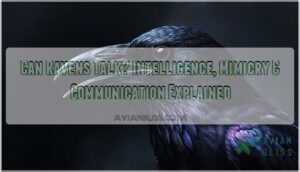This site is supported by our readers. We may earn a commission, at no cost to you, if you purchase through links.
When a raven perched on Edgar Allan Poe’s chamber door croaked “Nevermore,” readers accepted the dark magic without question—but the truth about whether ravens can actually talk proves far stranger than fiction. These corvids don’t just mimic human speech; they wield vocal tools with surgical precision, threading sounds through a dual-chambered syrinx that operates like two instruments played simultaneously.
While parrots might be the cocktail-party champions of mimicry, ravens approach vocalization with calculated intent, deploying their borrowed words and natural calls as strategic instruments within complex social hierarchies.
Your fascination with raven speech isn’t misplaced—it’s a window into one of nature’s most intricate communication systems, where intelligence and anatomy converge to create something that challenges our comfortable boundaries between human language and animal sound.
Table Of Contents
- Key Takeaways
- Can Ravens Talk Like Humans?
- How Ravens Produce and Use Sounds
- Raven Intelligence and Vocal Mimicry
- Why Ravens Mimic Human Speech
- The Role of Vocalization in Raven Society
- Frequently Asked Questions (FAQs)
- Do ravens have the ability to talk?
- Can a raven really say “nevermore”?
- Can you teach ravens to speak?
- Can you train a raven to talk?
- How do people react to Joe the talking raven?
- Can a raven form words and talk?
- Can a raven talk like a parrot?
- Can a raven talk like a human?
- Can a raven be trained to talk?
- Can a crow talk?
- Conclusion
Key Takeaways
- Ravens mimic human speech through a dual-chambered syrinx that permits sophisticated sound reproduction, yet their vocalizations lack the grammatical structure and semantic comprehension that define true language, distinguishing mimicry from genuine linguistic communication.
- Captive ravens demonstrate significantly enhanced vocal learning compared to wild populations due to repeated exposure to human speech, environmental enrichment, and social reinforcement, with some individuals mastering vocabularies exceeding 100 distinct sounds deployed with apparent contextual awareness.
- Raven vocalizations serve as strategic instruments within complex social hierarchies, coordinating foraging activities, establishing territorial boundaries, encoding predator-specific alarm information, and cementing alliance bonds through at least 20 distinct call types documented in field studies.
- The cognitive architecture supporting vocal mimicry in ravens reflects problem-solving intelligence and auditory-vocal integration through specialized neural pathways, though parrots surpass ravens in vocabulary breadth due to differences in brain structure and dedicated vocal learning mechanisms.
Can Ravens Talk Like Humans?
You’ve probably heard ravens croak and caw in the wild, but the question of whether they can actually talk like humans requires understanding what “talking” really means. Ravens can mimic human words with surprising accuracy, yet their vocalizations differ fundamentally from human speech in both structure and purpose.
Some species, like those featured in this guide to birds that mimic humans, demonstrate cognitive abilities that go far beyond simple repetition.
To understand this distinction, you need to examine how raven vocalizations compare to human language, the mechanisms behind their mimicry abilities, and the inherent limitations of their “talking.
Ravens use their advanced syrinx—the avian vocal organ—to mimic human speech, though understanding what makes crows and ravens produce unusual vocalizations reveals they’re copying sounds without grasping meaning.
Differences Between Raven Vocalizations and Human Speech
How do raven vocalizations differ from genuine human speech? The gap lies in cognitive basis and vocal anatomy. Ravens produce intricate calls through their syrinx, enabling vocal mimicry of human words, yet they lack the structured speech patterns defining true language:
Understanding why birds sing songs reveals how vocal complexity alone doesn’t equal linguistic meaning—ravens mimic sounds without grasping grammar or abstract concepts.
- Communication styles: Ravens use croaks, rattles, and clicks for species-specific signaling rather than symbolic abstraction.
- Vocal anatomy: Their syrinx permits rapid modulations but doesn’t form discrete phonemes like human vocal tracts.
- Intelligence application: Raven calls coordinate social behavior, not cultural transmission through rule-governed grammar.
How Ravens Mimic Words and Sounds
You’ve probably wondered how these brainy birds pull off their vocal tricks. Through auditory learning, ravens fine-tune sound reproduction by listening and practicing repeatedly. Their mimicry patterns emerge from environmental echoes—captive ravens exposed to human speech develop impressive vocal imitation skills.
The syrinx facilitates flexible vocal learning, letting them replicate diverse vocalizations from wolf howls to mechanical noises, though mimicry behavior fulfills social bonding rather than true linguistic communication.
Limitations of Raven “Talking”
While vocal learning gives ravens impressive mimicry behavior, their cognitive limits prevent true language mastery. The syrinx function produces isolated words rather than grammatically structured sentences, and brain structure lacks human-like language networks.
Vocal mimicry degrades without constant reinforcement, and intelligence doesn’t translate to linguistic comprehension.
You’ll notice their raven communication fulfills immediate social purposes—mimicry context matters more than abstract meaning, distinguishing their vocalizations from genuine speech.
How Ravens Produce and Use Sounds
You might wonder how ravens create such a diverse array of sounds, from guttural croaks to eerily accurate imitations of human speech. The answer lies in a specialized vocal organ called the syrinx, which functions quite differently from the human larynx and allows ravens impressive acoustic flexibility.
This unique vocal anatomy of birds enables ravens to manipulate sound with remarkable precision, producing everything from melodic whistles to complex mimicry that can fool even experienced listeners.
Understanding this biological foundation, along with their natural vocal repertoire and communication strategies in the wild, reveals how these birds have evolved one of nature’s most intricate sound-production systems.
Structure and Function of The Raven’s Syrinx
At the base of a raven’s trachea sits a complex dual-chambered organ called the syrinx, which functions as the biomechanical engine driving their impressive vocal mimicry and intelligence-linked vocalizations. You’ll find this avian physiology marvel facilitates precise sound production through:
- Independent left and right sound-generating chambers permitting simultaneous dual-note sequences
- Specialized syringeal muscles modulating membrane tension for pitch control
- Coordinated respiratory cycles synchronizing airflow with neural control pathways
- Beak and tongue positioning that sculpts timbre variations
- Sensorimotor feedback mechanisms refining vocal mechanisms through practice
Range of Natural Raven Calls
You’ll encounter at least 20 distinct vocalizations in field studies documenting raven communication, spanning croaks, rattles, clicks, and alarm calls that demonstrate intricate acoustic adaptation. North American populations employ contact croaks and coordination rattles most frequently, though regional raven dialects introduce subtle pitch and duration variations across communities.
Alarm calls encode predator-specific information through call variations, while juveniles contribute novel sound imitation patterns that enrich social calls through vocal learning and mimicry within their acoustic environment.
Communication Purposes in The Wild
You’ll witness ravens deploying intricate animal communication systems across three primary wilderness contexts, where environmental cues trigger specific vocalization and mimicry patterns that reveal their survival intelligence:
- Foraging calls coordinate group activities, broadcasting food location and abundance while maintaining cohesion during resource acquisition
- Territorial alerts establish dominance hierarchies, defending critical resources through aggressive social chirping that communicates boundary enforcement
- Wildlife signaling through alarm calls conveys predator-specific danger levels, enabling rapid threat assessment within raven communication networks
Raven Intelligence and Vocal Mimicry
You can’t separate a raven’s vocal talents from its brain power—the two are locked together in ways that reveal just how sharp these birds really are. Ravens don’t just mimic for the sake of it; their intelligence drives when, why, and how they use sounds in social situations.
Understanding what sets them apart from other vocal learners, like parrots, shows you exactly what makes raven communication so exceptional.
Cognitive Skills Linked to Vocal Learning
You’ll find that raven cognitive flexibility drives their impressive vocal imitation abilities through complex sound mapping tasks. Their neural pathways, linking auditory feedback to song control nuclei, enable precise mimicry that correlates directly with problem-solving performance.
This auditory-vocal integration demonstrates avian cognition at its finest, revealing how bird intelligence operates through interconnected systems that support both vocalization and broader cognitive science applications.
Social Contexts for Mimicry
You’ll observe that ravens strategically deploy mimicry within avian social structure dynamics, particularly during group foraging scenarios where vocal bonding strengthens alliances. These mimicking maestros leverage environmental cues and bird communication to navigate hierarchical relationships, demonstrating intricate mimicry strategies that improve social learning opportunities.
Research correlates captive exposure with heightened animal communication frequency, revealing how group dynamics directly influence vocal repertoire development and strategic deployment in ravens.
Comparison With Other Talking Birds (e.g., Parrots)
Parrots outperform ravens in vocal learning strategies, demonstrating advanced mimicry evolution through specialized avian brain structure that aids extensive word replication. Comparative cognition studies reveal parrots maintain thousands of sounds through deliberate animal communication, while the raven’s mimicking maestro approach reflects adaptive flexibility rather than extensive vocabulary development in avian intelligence.
These intelligent birds employ social bonding mechanisms within densely structured flocks, whereas ravens use bird communication more opportunistically for territorial signals.
Why Ravens Mimic Human Speech
You’ve seen how ravens possess the cognitive machinery to mimic sounds, but understanding why they choose to replicate human speech requires examining the specific circumstances that trigger this behavior.
The environmental conditions surrounding a raven, particularly whether it develops in captivity or remains in wild populations, fundamentally shape its propensity for vocal imitation.
Research documentation provides concrete examples that clarify the mechanisms and motivations underlying this extraordinary communicative adaptation.
Environmental and Social Triggers for Mimicry
You’ll notice ravens don’t just parrot sounds randomly—environmental cues and social bonds drive their mimicry triggers. Captivity amplifies vocal learning through repeated exposure to human speech, while social behavior in groups encourages adaptive communication through imitation.
Consider these catalysts:
- Resource-rich environments spark vocal experimentation during social interaction
- Familiar group members accelerate adoption of novel sounds
- Play periods heighten mimicry frequency among socially cohesive flocks
- Alliance formation motivates strategic sound borrowing
This avian intelligence reveals how environmental cues shape communication complexity.
Differences Between Captive and Wild Ravens
Captive enrichment fundamentally reshapes raven behavior compared to wild populations—you’ll see this gap in vocal learning patterns. Environmental influences in aviaries expose ravens to repeated human speech, triggering heightened social adaptation and cognitive abilities absent in natural settings.
Brain development reacts to these acoustic novelties, producing broader mimicry repertoires. Wild ravens prioritize survival-linked calls for food coordination and territorial defense, revealing how wildlife ecology constrains intelligence in birds toward context-specific communication rather than cross-species imitation.
Examples of Raven Mimicry in Research
Research findings on vocal imitation reveal raven behavior under controlled conditions: captive western ravens reproduce human voices, retaining mimicry patterns for months when reinforced with food rewards—demonstrating cognitive adaptation tied to environmental influence.
Operant conditioning studies confirm goal-directed communication, where intelligence in birds drives selective sound reproduction.
Field observations show wild ravens mimic mechanical noises less frequently, illustrating how cognitive abilities shape mimicry patterns across contexts.
The Role of Vocalization in Raven Society
Ravens don’t just make noise—they orchestrate entire social systems through sound, wielding their vocalizations like tools to navigate the intricacies of group living.
Their calls serve as currency for everything from forging alliances to staking claims on resources, and each vocalization carries weight in the delicate balance of raven society.
Understanding how these birds use sound reveals the adaptive genius behind their survival strategies.
Using Calls for Social Bonding and Warning
You’ll discover that ravens deploy a complex arsenal of social calls to cement bonds and broadcast danger across their flock. Their communication system reveals vocal recognition among members, maintaining group cohesion through nuanced exchanges that showcase why they rank among the most intelligent animal species.
Key social bonding and warning signals include:
- Contact calls during foraging and roosting – maintaining vigilance while strengthening collective safety
- Soft affiliative vocalizations between pairs – nurturing long-term partnerships through intimate acoustic exchanges
- Alarm calls triggering rapid collective responses – recruiting flock members to mob predators or escape threats
- Individual vocal signatures enabling recognition – supporting stable social structures across generations
Communication for Food and Territory
Beyond these social bonds, you’ll witness ravens orchestrating intricate food signals and territorial calls that govern their survival landscape. Foraging communication facilitates cache sharing among trusted allies, while alarm calls double as food alerts announcing discovered carcasses.
Through social feeding networks and strategic ecological interactions, ravens broadcast resource claims, repel competitors from preferred territories, and coordinate collective exploitation of ephemeral opportunities—transforming vocalizations into economic tools.
Adaptive Advantages of Complex Vocalizations
Vocal adaptation drives survival through repertoire diversity, sharpening social recognition within groups where distinct alarm calls, food alerts, and rivalry calls reduce conflict costs.
You’ll observe behavioral adaptations that exploit environmental cues, triggering cooperative signals during resource shifts—vocalizations that coordinate foraging, deter rivals, and cement hierarchies without bloodshed.
Communication complexity becomes evolutionary currency, purchasing flexibility in unpredictable landscapes.
In the raven’s world, vocal sophistication isn’t decoration—it’s survival currency that buys adaptability when conditions shift
Frequently Asked Questions (FAQs)
Do ravens have the ability to talk?
You might be surprised to learn that ravens can imitate human speech through vocal learning. However, their cognitive flexibility doesn’t extend to true language comprehension like humans possess, despite their impressive problem-solving abilities and complex communication systems.
Can a raven really say “nevermore”?
Yes, ravens possess vocal imitation abilities sufficient to articulate “nevermore” when exposed to repeated human speech patterns in captivity, though this mimicry reflects environmental cues and raven intelligence rather than genuine linguistic comprehension or problem-solving communication.
Can you teach ravens to speak?
You can train captive ravens to imitate limited words through auditory feedback and social motivation.
However, their mimicry lacks syntactic structure, producing isolated phrases rather than fluid speech patterns due to inherent cognitive and anatomical limitations.
Can you train a raven to talk?
With consistent positive reinforcement and daily sessions targeting short phrases, you can train most ravens to mimic recognizable words. Success varies by individual cognitive development and usually requires several weeks to months of practice.
How do people react to Joe the talking raven?
Public perception of Joe splits sharply. Media coverage emphasizes entertainment value, driving fascination with avian mimicry.
Meanwhile, ornithology circles question the ethical implications of captive training and the potential misrepresentation of natural raven communication complexity.
Can a raven form words and talk?
Ravens demonstrate vocal imitation and sound reproduction through avian communication systems, yet language barriers prevent true speech. Their mimicry limits reflect ornithology’s understanding: problem-solving bird brains replicate sounds without semantic comprehension or structured conversation.
Can a raven talk like a parrot?
While you might hear captive ravens reproduce short human phrases, their mimicry limits fall short of parrots’ extensive vocabularies and combinatorial use.
This reflects differences in brain structure, vocal learning pathways, and lifelong avian intelligence development across ornithology studies.
Can a raven talk like a human?
You’ll discover that captive ravens develop vocal imitation abilities through social learning, reproducing short human phrases.
However, they lack true language comprehension or the syntactic brain structure necessary for genuine semantic communication in avian research.
Can a raven be trained to talk?
You can train captive ravens to mimic human speech patterns through consistent vocal training methods and repetition.
Though their avian language acquisition remains limited to short phrases rather than fluent conversation, reflecting constraints in their mimicry techniques and captive bird communication abilities.
Can a crow talk?
Yes, crows possess vocal imitation abilities comparable to ravens, reproducing human words and environmental sounds through their sophisticated syrinx structure.
However, their mimicry reflects bird intelligence and sound mimicry rather than genuine avian communication or problem-solving through language.
Conclusion
Studies reveal that captive ravens can master vocabularies exceeding 100 distinct sounds, including human words deployed with contextual awareness that suggests genuine comprehension rather than mindless repetition.
When you ask “can ravens talk,” you’re really asking whether intelligence can transcend biological limitations—and the answer reshapes our understanding of consciousness itself.
These birds don’t just borrow our language; they demonstrate that the gap between human and animal communication exists only in degree, not in fundamental kind.










